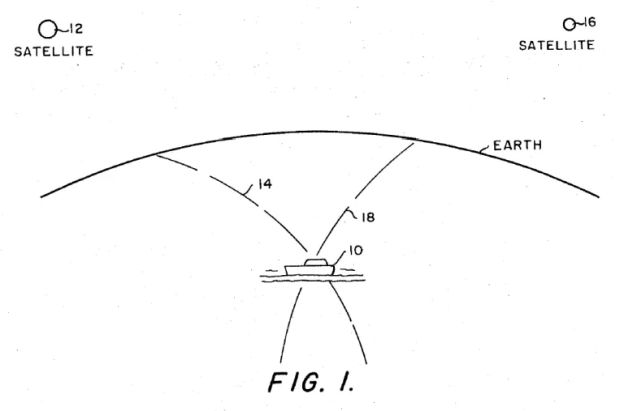This year sees the 50th anniversary of the grant of US 3,789,409, widely regarded as the original Global Positioning System (GPS) patent. It is no exaggeration to say that global satellite navigation systems (GNSSs), of which GPS is undoubtedly the most famous, are integral to the modern way of life. Aside from its obvious uses in navigation, the accurate timing signals provided by GPS satellites underpin much of our digital infrastructure. For example, telecoms networks rely on GPS time stamps to accurately synchronise communications and avoid interference, whilst financial transactions are timestamped with nanosecond accuracy by servers whose clocks are locked to a GPS timing signal.
The patent in question, US 3,789,409, was granted on 29 January 1974 to Roger Easton, who together with Ivan Getting and Bradford Parkinson is widely credited as creating the original GPS system (although Easton is named as the sole inventor on US'409). Easton's patent describes a method of using signals from a minimum of two satellites to determine the location of a ground-based receiver, by comparing the phases of the received signals to the phase of a reference signal produced by a local "extremely stable" oscillator at the receiver. The result of the comparison is then used to determine the instantaneous location of each satellite, which in turn allows the location of the receiver to be determined based on the intersection of lines of position for each satellite.
This method is neatly illustrated in Fig. 1, where line 14 shows points that are equidistant to satellite 12, and line 18 shows points that are equidistant to satellite 16. The intersection of lines 14 and 18 then gives the position of the receiver 10:

As an aside, the claim language used in US'409 neatly illustrates some of the ways in which patent practice has changed over the past half a century, and would no doubt raise eyebrows among most current practitioners. For example, it is difficult to imagine modern-day patent examiners accepting the comparative term "extremely stable" in a patent claim. Despite its questionable clarity, this wording appears not once but twice in claim 1, which defines each satellite as comprising a "first extremely stable oscillator" and the receiver as comprising a "second extremely stable oscillator".
To further confuse matters, the description notes that the oscillator at the receiver is "similar" (but perhaps not identical?) in frequency stability to the satellite's oscillator and describes the use of a different oscillators at the receiver and at the satellite, giving the example of an atomic clock at the receiver versus an ultra-stable crystal oscillator on the satellite. The use of different technologies would seem to cast doubt on whether "extremely stable" has one meaning in relation to the "first extremely stable oscillator", and another meaning in relation to the "second extremely stable oscillator". Continuing the theme of clarity, claim 1 also states that the instantaneous locations of the satellites are "precisely known" – how precise, and known to whom?
Another interesting point to note in claim 1 is that rather than defining the apparatus whose position is determined in broad terms (e.g. 'receiver'), the navigation system is defined as comprising a "navigator's station", perhaps betraying the naval origins of the technology (GPS was originally developed the US Navy). The description does at least attempt to broaden the scope of the term "navigator's station" by noting that this "could obviously be on a flying airplane" (is there any other kind of airplane?) rather than on a ship. In fairness, we can perhaps forgive the drafting attorney for not foreseeing the wider adoption of GPS beyond sea- and air-based navigation, given the teaching in the description that the oscillator at the navigator's station "would typically be controlled by an atomic clock", which in the 1970s would likely have been the size of a small suitcase, if not larger.
Putting the issues of claim language and drafting practice to one side, and returning to the matter of technology, according to US'409 an object of the invention was to allow the range to a satellite to be measured "without the necessity of transmitting an interrogatory signal". At the time, proposals for satellite navigation systems typically required the ground station to transmit a signal to each satellite, which would respond with its own signal. The time delay between the ground station transmitting its own signal and receiving a response from the satellite could be used to determine the time-of-flight of the signal, allowing the range to be calculated.
The US Navy was understandably concerned that such an approach would risk giving away the ground station's location, since an enemy might be able to detect the "interrogatory signals". The ability to determine a location without having to transmit signals to the satellites was evidently considered so significant as to be worthy of mention in claim 1, which defines the location as being determined "without the necessity of betraying the presence of said navigator's station by an interrogation signal".
As a final point, whilst it may be fair to say that US'409 is one of the earliest patents to have originated from the US Navy's GPS project, the technology described in US'409 arguably bears little resemblance to the system in its final form. By the time the first Block I Navstar/GPS satellites were launched in 1978, eight years after the filing date of US'409, the system's designers had moved away from the two-satellite approach that was described in US'409. Instead, an alternative solution was adopted in which the receiver determines the time-of-flight for signals received from four satellites, and proceeds to solve simultaneous equations to calculate four unknown variables: the three spatial coordinates x, y, z, and a time offset ∆t between the receiver's internal clock and the highly accurate (extremely precise...?) clocks onboard the satellites. So, whilst we can perhaps celebrate the 50th anniversary of the first GPS-related patent being granted, the true half-centennial of GPS as we now know it may still be a few years away – let the countdown begin! Now, where did I put that atomic clock...?
The content of this article is intended to provide a general guide to the subject matter. Specialist advice should be sought about your specific circumstances.
